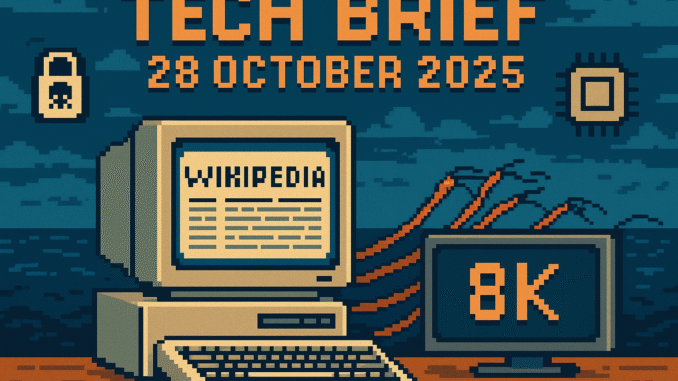
The internet we were promised in the 90s had one survivor this week, Jimmy Wales, who is still defending Wikipedia’s idealism while everyone else chased the money. Meanwhile, scientists confirmed your eyes can’t see 8K, the infrastructure holding it all together is creaking at the seams, and ransomware gangs offer better customer service than most legitimate software. Same web, completely different values.
Missed yesterday’s Tech Brief? Catch up here before diving in.
Today’s Tech Roundup
Jimmy Wales: Wikipedia’s Founder at 25 Years
Wikipedia, which turns 25 next year, and its founder Jimmy Wales remains the only tech baron who didn’t sell out. After his daughter’s near-fatal illness, Wales pivoted from Bomis’s web portal to build humanity’s free knowledge encyclopedia, not for profit, not for data harvesting, just for knowledge.
The Guardian’s profile explores how Wikipedia became the internet we were actually promised back in the 90s: peer collaboration, open access, volunteer-driven. While everyone else chased IPOs and surveillance capitalism, Wales stuck to the original vision. Now Wikipedia faces threats from AI scrapers mining its content and attacks like Elon Musk’s “Wokipedia” branding.
The technical achievement is remarkable. Billions of requests served on donations and volunteer labour, while Facebook burns server farms for ad targeting. Same web, completely different values. Wales embodies the idealism that built the early internet, and he’s still defending it.
Scientists Confirm Your Eyes Don’t Care About 8K
Can you actually see the difference between 4K and 8K from your sofa? University of Cambridge and Meta researchers say no. At typical living room viewing distances, 8K displays offer no perceptible advantage over 4K screens. The resolution race plateaued years ago, but the marketing departments are still flogging it like it’s 1999 and megahertz matter.
This is classic tech industry bollocks, the same pattern as megahertz myths in the 90s. More must be better, right? Except human biology has limits. The jump from composite to RGB was transformative. CRT to LCD changed everything. But 4K to 8K at three metres? Your retinas literally cannot resolve the difference. The research confirms what anyone who grew up with VHS tracking errors instinctively knows: there’s a point where good enough is genuinely good enough, and we passed it ages ago.
The Internet Isn’t Forever: Infrastructure Report Reveals Fragility
The internet runs on undersea cables laid in the 90s, DNS systems held together with hope, and aging routers that should’ve been retired years ago. The Guardian’s investigation into global connectivity infrastructure exposes what network engineers have been quietly warning about for years: it’s more fragile than anyone wants to admit. Internet experts outline realistic scenarios for cascading failures that could take down entire regions. The network we treat like gravity, assumed and permanent, is actually mortal and aging. When did we forget the internet could break?
LockBit 5.0 Launches With Expanded Targeting
The LockBit ransomware operation is back with version 5.0, and if you’ve ever been stuck in a legitimate software vendor’s support queue for three days, you’ll appreciate the dark irony: these criminals answer faster. Technical upgrades, wider targeting scope, and the same ransomware-as-a-service model that’s been plaguing enterprise infrastructure for years.
This isn’t the pranks and proof-of-concept viruses from the 90s. Modern ransomware is professional: customer service teams, SLAs, negotiation specialists. It’s malware with better support than most legitimate software vendors provide, which tells you everything about where we’ve ended up.
Computer Weekly reports that LockBit 5.0 represents an escalation in both capability and ambition. The encryption schemes are more sophisticated, the propagation methods more resilient, and the payment infrastructure more robust. For anyone managing IT security, this is the current battlefield.
The lineage is clear. Early viruses were chaos agents. Worms like Code Red spread for the sake of spreading. But ransomware has a business model, and business is good. That’s the bit that should worry you. And when that aging infrastructure we mentioned earlier finally gives way? These are the operations positioned to exploit every crack in the foundation.
From the Wayback Machine
On This Day: 1937, Marcian “Ted” Hoff Born, Co-Inventor of the Microprocessor
Ted Hoff was born on 28 October 1937 in Rochester, New York. You’ve probably never heard of him, but you’re using his idea right now. As Intel’s 12th employee in 1968, Hoff proposed building a universal processor rather than custom logic chips. That decision led to the Intel 4004, announced in 1971. While Steve Jobs and Bill Gates became household names, Hoff remained in the background, but his architectural vision is the reason any of their software could exist. The world’s first commercial microprocessor featured 2,300 transistors, ran at 740 kHz, and used 4-bit architecture. The concept seems obvious now, but in 1971 it was revolutionary. One chip that could do anything if you just changed the software. That paradigm shift enabled everything from the ZX Spectrum to the phone in your pocket. Hoff’s architecture won, and we’re still using it 54 years later.
The Pattern
Today’s Tech Brief 28 October 2025 highlights a pattern: the gap between what we were promised and what we got. Wikipedia succeeded where everything else failed. Ultra-HD is marketing hype masquerading as progress. The internet’s infrastructure is aging while we pretend it’s eternal. And ransomware has professionalised into an industry. The idealism that built the early web is under siege from all sides, but at least Jimmy Wales is still fighting.
Keep your backups local, your scepticism healthy, and your Wikipedia donations current. The internet we wanted is still worth defending.
Missed yesterday’s Tech Brief? Catch up here.

Leave a Reply